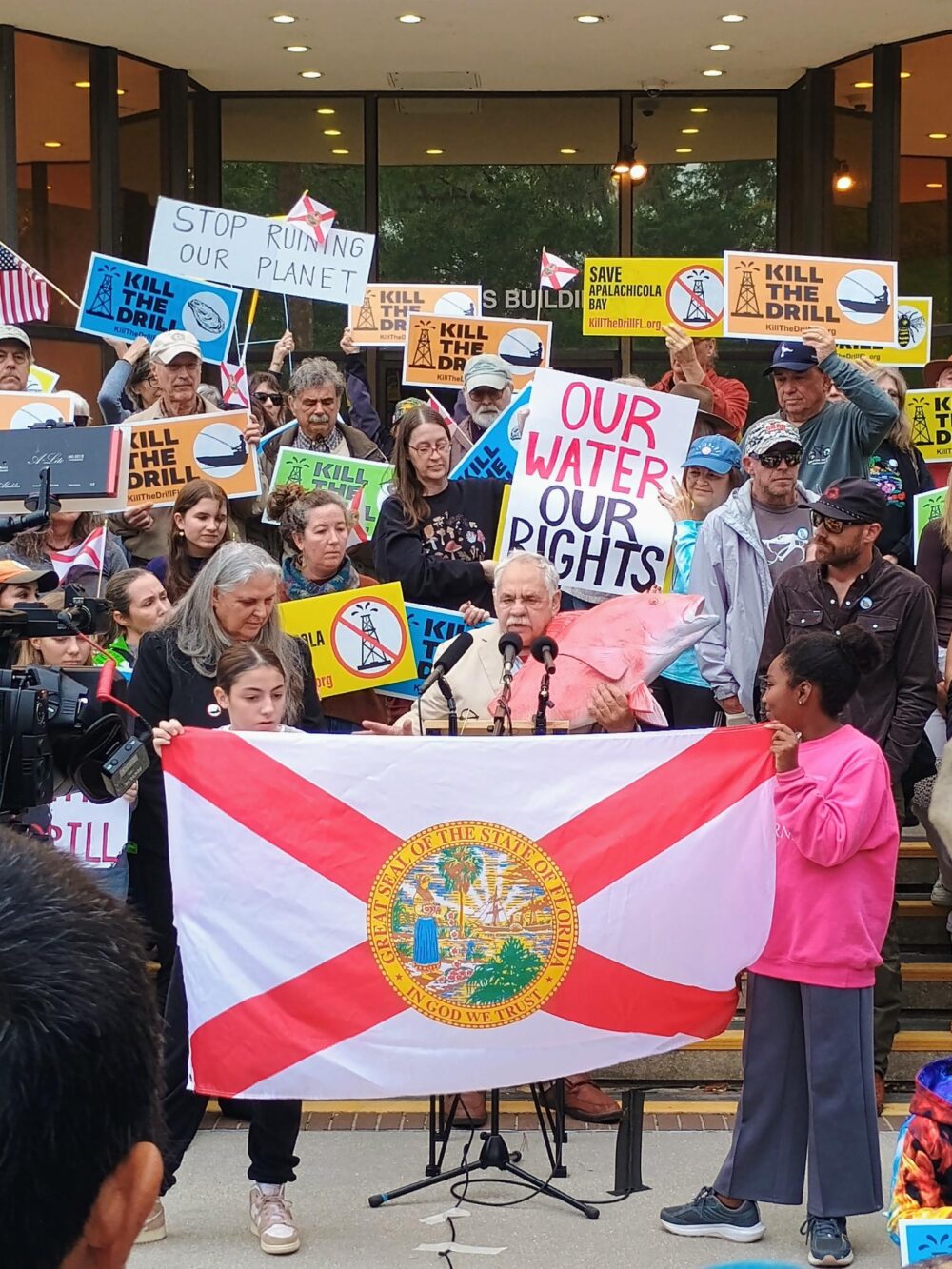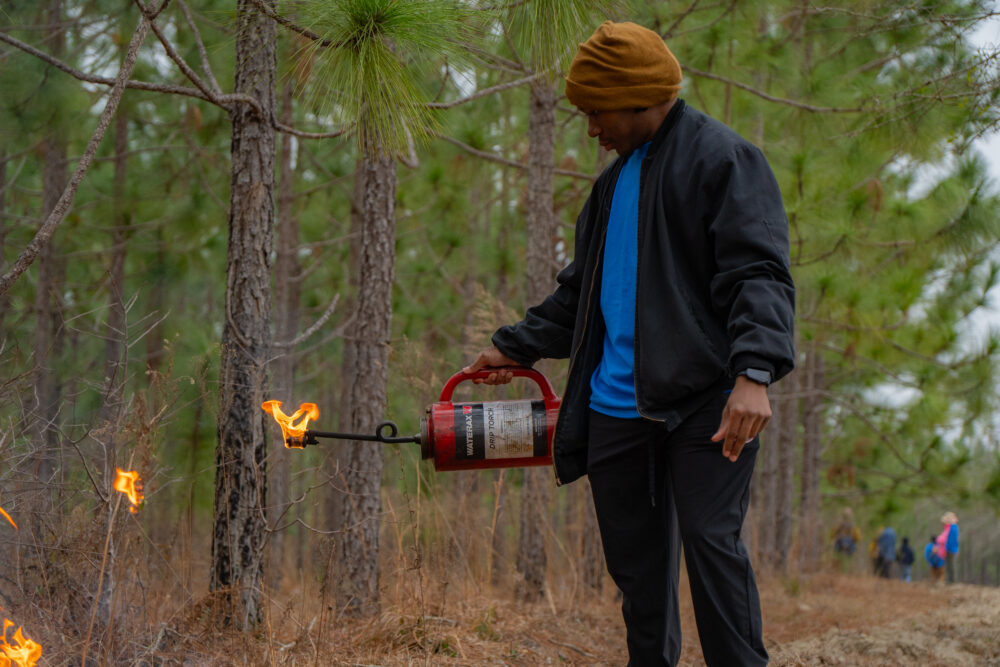We have much more to do and your continued support is needed now more than ever.
Settle the BP Oil Spill Litigation? Maybe, But Let’s Not Let BP Shortchange the Gulf Yet Again
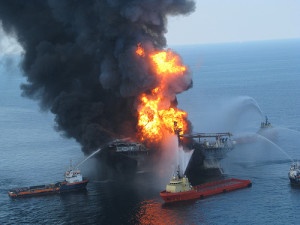
The trial was set to begin this week, but it was postponed to allow more time for settlement talks between BP and its co-defendants on the one side, and the U.S., the five Gulf states, and numerous injured people and businesses on the other.
The stakes for people and wildlife have never been higher in an environmental lawsuit.
The explosion at BP’s Macondo well was by far the largest environmental disaster in the U.S. history; the well gushed 206 million gallons of oil, nearly 20 times the amount released by the Exxon Valdez.
Among other harmful effects of the Gulf disaster on wildlife and natural resources, it badly damaged coastal wetlands that provide nurseries for much of the Gulf’s seafood and shellfish.
The oil continues to wash ashore and will do so for many years, causing untold damage to wetlands and other sensitive ecosystems. The remaining oil continues to threaten populations of whales, dolphins, sea turtles, deep sea corals and a host of other marine species.
Will BP and its Co-Defendants Be Held Responsible for Restoring the Gulf?
If the right amount of money and the right legal framework for Gulf restoration can be secured, and the costs and uncertainties of trial can be avoided, settlement of the environmental claims would be a very positive thing. However, government attorneys face all kinds of pressures to settle cases on terms that shortchange the environment.
Ultimately, it is up to our elected officials – President Obama and the five Gulf state governors – to ensure that justice is truly done for the Gulf, its wildlife, and the many people who depend on the Gulf’s health for their livelihoods and quality of life.

According to the relevant environmental laws (described below), BP and its co-defendants are responsible not only for fully restoring the Gulf’s natural resources to their pre-spill condition, but also for many billions of dollars of civil and criminal penalties based on the magnitude of the spill and the recklessness of the behavior that caused it.
Fairness and common sense dictate – as the official oil spill commission and other major studies all have called for, and as the President has promised – that those billions be directed back to the Gulf Coast as a much-needed down payment toward rectifying the decades of environmental insults inflicted upon the ecosystem by the oil industry and others.
Good public process also mandates ensuring citizen oversight and scientific input into the many decisions affecting the health of the Gulf that will be made over the course of settlement implementation. And, given the many unknowns about future impacts of the Gulf disaster on wildlife and natural resources, any deal also must contain a strong reopener provision, one with an enforceable trigger and a reliable funding mechanism to remedy environmental problems if impacts prove to be worse than predicted.
Some commentators have suggested that a $15-$30 billion settlement amount is likely. As discussed below, such amounts may prove to be inadequate. As the details emerge about the government’s draft plan to restore the Gulf to its pre-spill condition, it may become apparent that tens of billions of dollars are needed for this purpose alone. Civil and criminal penalties will add tens of billions of additional liability. The key principles of criminal law – deterring future bad behavior and expressing society’s condemnation of wrongdoing – both must come into play here. Given BP’s financial resources – it netted $25.7 billion in profits in 2011 – the Obama administration and the five Gulf states should make full use of their authorities to secure settlement payments large enough to send a powerful message about the seriousness of the disaster that BP and its co-defendants created.
Factors to Consider in Evaluating a Proposed Settlement
Recent reports suggest that settlement talks about environmental claims are on a much slower track than those involving the tort and admiralty claims filed by individuals and businesses; however, a settlement deal on the environmental claims could emerge in the coming weeks.
If and when a proposed settlement is announced, NWF will insist that it be placed before the public for review and comment before it is finalized. This topic is far too important to be left entirely in the hands of a small number of decision makers in a closed-door settlement conference in New Orleans.
At this juncture, before the details of any settlement are released, reaching any conclusion about what would be a fair settlement amount for the environmental portion of BP’s and its co-defendants’ liability is extremely difficult. Rather than attempting to reach such a conclusion, I will focus on some of the key factors that must be considered.
Lesson Learned: Don’t Trust the Assessments of BP and its Allies
During the first year of the nation’s largest oil spill disaster, BP invested enormous sums in creating the false impression that the devastation in the Gulf was not so bad and that everything was under control.
For example, BP estimated that a mere 1,000 barrels were gushing from the Macondo well each day; the actual figure turned out to be 53,000.
As we approach the second anniversary, BP is at it again, launching 60 second commercials and online ads peddling its “ongoing commitment” to clean up the Gulf and preaching how all is well there. A key task in evaluating any settlement will be ensuring that it confronts the real problems facing the Gulf ecosystem and does not adopt the BP approach of sweeping problems under the rug.
Tallying up the Environmental Law Violations
Three types of payments for environmental law violations must be assessed against BP and its co-defendants: cleanup costs, restoration costs and civil and criminal penalties.
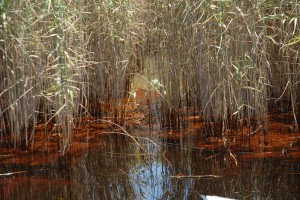
2. Restoration costs. The Oil Pollution Act states that the responsible parties must pay the costs of restoring natural resources back to the condition they were in at the time of the disaster.
Restoring the Gulf will be an extremely complex enterprise; no one has ever attempted to rectify an environmental disaster of this magnitude. Some of the natural resources destroyed by the oil, such as wetlands at the very edge of the Mississippi delta, do not appear to be replaceable at their original locations, and so difficult judgments must be made about which newly-restored habitats would create resources of equivalent value.
Although a few relatively small early restoration projects have been identified, the full federal restoration plan is not expected to be completed until late 2012 at the earliest. Until that plan’s restoration actions and costs are vetted with the public, it is very difficult to estimate what kind of payment will be needed to truly restore the Gulf back to its condition in April 2010. For now, the best guide is the settlement agreement in the next-largest oil disaster in the country, the grounding of the Exxon Valdez tanker in April 1989. In that case, the per-gallon amount paid by Exxon for restoration Alaska’s Prince William Sound was $152 (inflation-adjusted to reflect today’s dollars). Assuming the parties to the Gulf disaster negotiation settle at roughly the same per-gallon amount for the 206 million gallons released from the Macondo well, a restoration payment in the amount of $31 billion would be in order.
Some will argue that focusing on the Exxon Valdez settlement amount obscures the important differences between Prince William Sound and the Gulf of Mexico. It is true that oil breaks down more rapidly in the warm water of the Gulf than in the cold water in Alaska. And it is true that restoration work in Alaska required costly transportation of people and infrastructure from the lower 48 states. On the other hand, there are challenges in the Gulf that did not exist in Prince William Sound, such as the impacts of large volumes of dispersants, the difficulty of skimming off lighter crude, and the near impossibility of removing oil from wetlands.
Ultimately, the methodology for calculating restoration costs in the Gulf needs to be much more sophisticated than applying the Alaska per-barrel restoration cost in the Gulf. However, looking at the per-barrel cost in Alaska tells an important story about how very expensive restoration projects can be.
3. Civil and Criminal Penalties. The third and final category of environmental payments are the civil and criminal penalties owed under the applicable environmental laws, such as the Clean Water Act, Migratory Bird Treaty Act, Marine Mammal Protection Act, Endangered Species Act, and Outer Continental Shelf Lands Act. These penalties provide a critical mechanism for addressing the legacy of environmental injuries inflicted on the Gulf by the oil industry and others.
In estimating a fair settlement amount under these statutes, it is crucial to evaluate the evidence of whether BP and any of its co-defendants were grossly negligent in their operation of the Macondo well. A finding of gross negligence would lead to substantially higher civil penalties under the Clean Water Act and a greater likelihood of criminal prosecution as well.
Few if anyone would dispute that BP, rig owner Transocean Ltd. and cement contractor Halliburton Energy Services Inc. share the blame for taking unnecessary risks at the Macondo well. Investigations performed by the Coast Guard, the Department of the Interior and the presidentially-appointed oil spill commission all concurred that a host of reckless actions by these companies to save time and money led inexorably to the disastrous blowout. The facts of the case clearly point to gross negligence.
Clean Water Act Penalties
The Clean Water Act provides for a minimum civil fine of $1,100 per barrel of oil discharged into navigable waters by owners, operators, or persons in charge of offshore facilities or vessels. However, for any defendant found to be grossly negligent or engaged in willful misconduct, the penalty is $4,300 per barrel spilled. Thus, with 4.1 million barrels of oil released into the Gulf and a likely gross negligence finding against BP and Transocean, one could reasonably expect civil Clean Water Act liability for these defendants at up to $17.6 billion each. Liability for the other owners and operators would likely be substantially lower.

It is appropriate to think in terms of billions of dollars when considering criminal liability for BP, Transocean and Halliburton under the Clean Water Act, however.
University of Michigan Professor David Uhlmann, former chief of the Justice Department’s environmental crimes unit, states that “a multi-billion-dollar criminal fine for BP is likely.” Moreover, according to Professor Uhlmann, “the total criminal sentence – a combination of fines, restitution and restoration projects – may reach into the tens of billions of dollars.” Uhlmann characterizes the Gulf oil spill as “the most significant environmental case ever prosecuted.”
In deciding what kind of settlement of Clean Water Act criminal penalties is acceptable, prosecutors will consider not only the defendants’ negligence, but also ability to pay, the unprecedented damage to the environment caused by the defendants’ actions, the need to deter future violations and the need for society to make a strong expression of condemnation.
With these factors in mind, and based on the facts publicly available, I estimate that a fair settlement of civil and criminal penalties under the Clean Water Act would require a combined payment of well over $25 billion from all defendants, with BP contributing the lion’s share in light of its ability to pay.
MBTA, MMPA, ESA and OCSLA
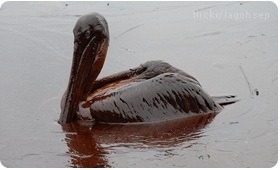
Ensuring that Clean Water Act Civil Penalties are used for Gulf Restoration
Under the Clean Water Act, civil penalties recovered by the federal government due to oil spills are deposited into the Oil Spill Liability Trust Fund, where they may be used for oil spill cleanups anywhere in the country. This provision is problematic in this case, where fairness calls for using penalties now to remedy the legacy of environmental harms inflicted on the Gulf of Mexico by the oil and gas industry and others.
To ensure that Clean Water Act civil penalties are invested in Gulf recovery, Senators Landrieu, Shelby, Nelson and others have introduced the Restore the Gulf Coast Act of 2011 (RESTORE). The bipartisan bill, which dedicates 80% of potential Clean Water Act civil penalties to restoration of the Gulf, has already cleared a key committee and is poised for a possible full Senate floor vote as part of the transportation bill. National Wildlife Federation is part of a broad coalition of organizations strongly supporting RESTORE in part because we believe it is the surest way to ensure that Clean Water Act penalties are not diverted to the federal treasury.
If Congress fails to pass RESTORE, two settlement strategies are potentially available to direct necessary funds to restoration. First, the CWA enables the EPA to negotiate a settlement in which penalties are reduced in return for the violator making a contribution of a similar amount to environmental restoration projects in the affected area. An advantage of this “Supplemental Environmental Projects” approach is that the projects are identified at the time of the settlement and thus the government can ensure that financial resources are focused on Gulf restoration. The recent CWA settlement with MOEX, an owner of a small share of the Macondo well, shows that the government can use the SEP tool to keep at least some CWA civil penalties in the Gulf.
Second, the government plaintiffs can potentially structure a settlement to ensure that the bulk of payments are made by defendants pursuant to environmental laws other than the CWA civil penalty provisions, such as the Oil Pollution Act and the CWA criminal penalty provisions.
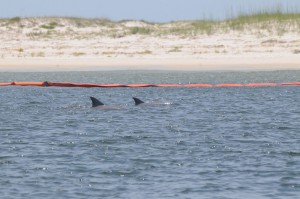
The clock is ticking. Coastal Louisiana is currently losing an average of 16.5 square miles of wetlands each year, due in part to oil and gas development. The BP disaster worsens this situation because oil kills the vegetation that holds wetlands together. If no restoration is undertaken, scientists estimate the state could lose an additional 1700 square miles over the next 50 years, with the resulting loss of vital habitats and a crucial storm buffer for New Orleans and other communities.
BP and its co-defendants owe a very large debt to the nation for the April 2010 disaster in the Gulf of Mexico, probably well in excess of the $15- $30 billion estimate put forward by some in the media.
Help ensure that the Gulf ecosystem and its wildlife benefit from any BP settlement











